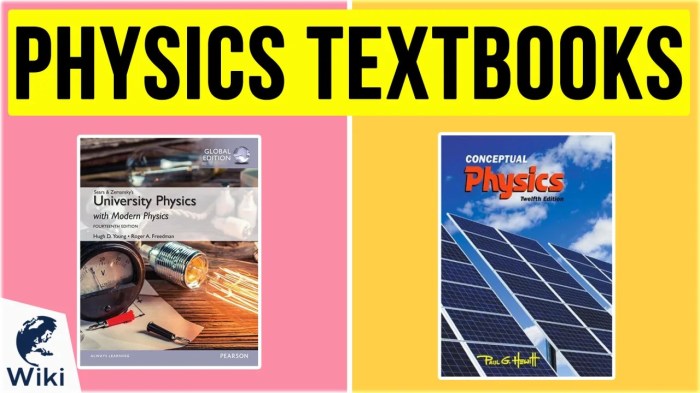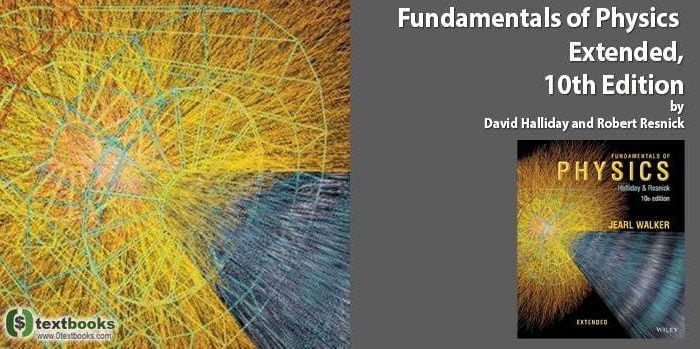Delving into the fundamentals of physics textbook PDF, this introduction immerses readers in a unique and compelling narrative, with an authoritative tone that is both engaging and thought-provoking from the very first sentence.
This comprehensive guide provides a thorough exploration of the essential concepts, structure, and applications of physics textbooks in PDF format. By understanding the significance of these textbooks and the benefits of using them in a digital format, students can optimize their learning experience and gain a deeper understanding of the fundamental principles of physics.
Introduction
Physics textbooks are essential resources for understanding the fundamental principles and concepts of physics. They provide a structured and comprehensive overview of the subject, covering a wide range of topics from mechanics to electromagnetism.
Using a PDF format for textbooks offers several benefits. PDFs are easily accessible, portable, and can be stored and organized on various devices. They also allow for easy searching and highlighting, making it convenient for students to navigate and study the material.
Benefits of PDF Textbooks
- Easy accessibility and portability
- Convenient storage and organization
- Enhanced search and highlighting capabilities
Essential Concepts in Physics Textbooks
Physics textbooks introduce students to the fundamental principles that govern the physical world. Understanding these core concepts is crucial for building a solid foundation in physics and for comprehending more advanced topics.
Essential concepts typically covered in physics textbooks include:
- Motion:Describing and analyzing the movement of objects, including kinematics (describing motion) and dynamics (explaining the causes of motion).
- Energy:Understanding different forms of energy (such as kinetic, potential, and thermal) and how they can be transferred and transformed.
- Forces:Identifying and analyzing forces that act on objects, including gravitational, electromagnetic, and nuclear forces.
- Waves:Exploring the properties and behaviors of waves, including mechanical waves (such as sound and water waves) and electromagnetic waves (such as light and radio waves).
- Electricity and Magnetism:Studying the interactions between electric charges and magnetic fields, including circuits, electromagnetism, and electromagnetic induction.
- Quantum Mechanics:Introducing the principles of quantum mechanics, which describes the behavior of matter at the atomic and subatomic levels.
Mastering these essential concepts provides a strong foundation for understanding the physical world and for further exploration in physics and related fields.
Physics Textbook Structure
Physics textbooks typically follow a structured organization to present the subject’s fundamental concepts and principles. This structure aids in organizing and presenting physics concepts in a logical and sequential manner.
Physics textbooks are typically divided into chapters, which are further divided into sections and subsections. Chapters typically cover broad topics within physics, such as mechanics, electricity, or quantum mechanics. Sections within a chapter focus on specific aspects of the topic, while subsections delve into even more detail.
Chapters
Chapters in physics textbooks serve as the primary organizational units for presenting physics concepts. Each chapter typically covers a major topic or area of study within physics. Chapters are usually organized in a logical sequence, building upon concepts introduced in previous chapters.
Sections
Sections within a chapter focus on specific aspects or s of the chapter’s main topic. Sections provide a more detailed exploration of the concepts introduced in the chapter, often presenting derivations, proofs, or specific applications of the principles discussed.
Subsections
Subsections further divide sections into even more specific topics or s. Subsections provide a detailed and focused examination of specific aspects of the section’s topic, often presenting additional examples, derivations, or applications.
Examples and Applications
Incorporating real-world applications of physics concepts enhances student understanding and illustrates the practical relevance of the subject. Examples can help students visualize abstract concepts and make connections to their daily lives.
By grounding physics principles in relatable contexts, students can develop a deeper appreciation for the role physics plays in shaping the world around them.
Examples of Real-World Applications
- Motion and Forces:Understanding the principles of motion helps design and build vehicles, predict the trajectory of projectiles, and analyze the forces acting on structures.
- Energy and Power:Principles of energy conversion and power generation are crucial in designing efficient energy systems, optimizing resource utilization, and addressing global energy challenges.
- Electromagnetism:Electromagnetic phenomena underpin the operation of electrical devices, communication systems, and medical imaging technologies.
- Waves and Optics:Understanding wave behavior and optics enables the development of optical instruments, fiber optic communication, and imaging technologies.
- Quantum Mechanics:Quantum principles revolutionized our understanding of the atomic and subatomic world, leading to advancements in electronics, computing, and materials science.
Problem-Solving Techniques
Physics textbooks introduce various problem-solving techniques that guide students in analyzing and solving physics problems effectively. These techniques are crucial for developing critical thinking, analytical skills, and the ability to apply physics concepts to real-world situations.
The problem-solving process typically involves several key steps, including identifying the problem, analyzing the given information, formulating a solution strategy, executing the strategy, and evaluating the solution.
Identify the Problem
The first step is to clearly understand the problem statement and identify the physics concepts involved. Students should carefully read the problem and extract relevant information, including the initial conditions, constraints, and desired outcomes.
Analyze the Given Information
Once the problem is identified, students should analyze the given information and determine which physics principles and equations are applicable. They should identify the relevant variables and their relationships.
Formulate a Solution Strategy
Based on the analysis, students should formulate a solution strategy that Artikels the steps they will take to solve the problem. This may involve choosing appropriate equations, setting up a coordinate system, or making simplifying assumptions.
Execute the Strategy
The next step is to execute the solution strategy by performing mathematical calculations and applying physics principles. Students should show all their work and clearly explain their reasoning.
Evaluate the Solution
Finally, students should evaluate the solution to ensure it is reasonable and consistent with the given information. They should check for units and significant figures, and consider whether the solution makes sense in the context of the problem.
Simulations and Visualizations

Simulations and visualizations play a vital role in enhancing the understanding of physics concepts by providing immersive and interactive experiences that complement traditional textbook learning. These tools offer numerous benefits, such as:
- Visualizing complex phenomena:Simulations and visualizations allow students to visualize abstract and complex physics concepts in a concrete and dynamic way, making them more accessible and comprehensible.
- Interactive exploration:Students can interact with simulations and visualizations, varying parameters and observing the resulting changes in real-time. This hands-on approach fosters a deeper understanding of the underlying principles.
- Experimental insights:Simulations can replicate experimental setups, enabling students to conduct virtual experiments and gather data without the limitations of physical resources. This provides valuable insights into experimental design and data analysis.
Benefits of Using Simulations and Visualizations, Fundamentals of physics textbook pdf
In addition to the benefits mentioned above, using simulations and visualizations to supplement textbook learning offers several other advantages:
- Increased engagement:Interactive simulations and visualizations captivate students’ attention and make learning more engaging and enjoyable.
- Improved retention:Visual representations and hands-on experiences enhance memory and promote long-term retention of concepts.
- Enhanced problem-solving skills:By manipulating simulations and visualizing different scenarios, students develop critical thinking and problem-solving abilities.
- Real-world applications:Simulations can demonstrate the practical applications of physics concepts, bridging the gap between theory and real-world phenomena.
Assessment and Evaluation

Assessment and evaluation are crucial components of effective physics education. They provide insights into students’ understanding and help tailor instruction to meet their individual needs.
Formative assessments are conducted throughout the learning process to monitor students’ progress and identify areas where they need additional support. Summative assessments, on the other hand, are typically administered at the end of a unit or course to evaluate overall learning outcomes.
Formative Assessments
Formative assessments are designed to provide timely feedback to students and instructors. They can take various forms, including:
- Quizzes and short answer questions
- Class discussions and peer reviews
- Concept mapping and problem-solving exercises
Summative Assessments
Summative assessments are used to measure students’ overall understanding of a topic or course. They are typically more comprehensive than formative assessments and may include:
- Exams and tests
- Projects and research papers
- Presentations and portfolios
Both formative and summative assessments play vital roles in physics education. They help identify areas for improvement, motivate students to engage with the material, and provide evidence of student learning.
Technology in Physics Education
In modern physics education, technology plays a crucial role in enhancing learning experiences and fostering deeper understanding of physics concepts. It offers a plethora of online platforms, simulations, and interactive tools that cater to diverse learning styles and facilitate the exploration of complex phenomena.
Online platforms provide access to a vast repository of educational resources, including video lectures, interactive simulations, and problem-solving tools. These platforms enable students to learn at their own pace, revisit concepts as needed, and engage with peers and instructors from anywhere with an internet connection.
Simulations and Interactive Tools
Simulations and interactive tools allow students to visualize and interact with physics concepts in a dynamic and engaging way. These tools enable them to explore phenomena that may be difficult or dangerous to observe in real-world settings, such as the motion of celestial bodies or the behavior of particles in quantum mechanics.
Tips for Effective Textbook Use
Effective textbook use is essential for success in physics. Physics textbooks are a valuable resource that can provide students with a wealth of information and insights. However, it is important to use textbooks effectively in order to get the most out of them.
There are a number of strategies that students can use to improve their textbook use. These strategies include:
Previewing the Material
Before reading a new chapter, take some time to preview the material. This will help you to get a general idea of what the chapter is about and to identify any key concepts that you need to focus on.
Active Reading
When you read your textbook, don’t just passively read the words. Instead, actively engage with the material. This means highlighting important concepts, taking notes, and asking yourself questions about what you are reading.
Note-Taking
Taking notes is a great way to improve your comprehension and retention of the material. When you take notes, be sure to focus on the key concepts and to use your own words. You may also want to use different colors of ink or highlighters to help you organize your notes.
Problem-Solving
Physics is a problem-solving discipline. The best way to learn physics is to practice solving problems. When you work through problems, be sure to show all of your work and to check your answers. You may also want to work with a study group or tutor to get help with difficult problems.
Reviewing the Material
It is important to review the material regularly. This will help you to retain the information and to identify any areas where you need additional help. You may want to review the material by yourself, with a study group, or with a tutor.
Questions and Answers: Fundamentals Of Physics Textbook Pdf
What are the advantages of using a physics textbook in PDF format?
Physics textbooks in PDF format offer several advantages, including portability, accessibility, searchability, and cost-effectiveness.
How can I effectively use a physics textbook?
To effectively use a physics textbook, engage actively with the material, take notes, solve problems regularly, and seek clarification when needed.
What are the key concepts covered in a typical physics textbook?
Typical physics textbooks cover core concepts such as mechanics, thermodynamics, electromagnetism, waves, and quantum physics.